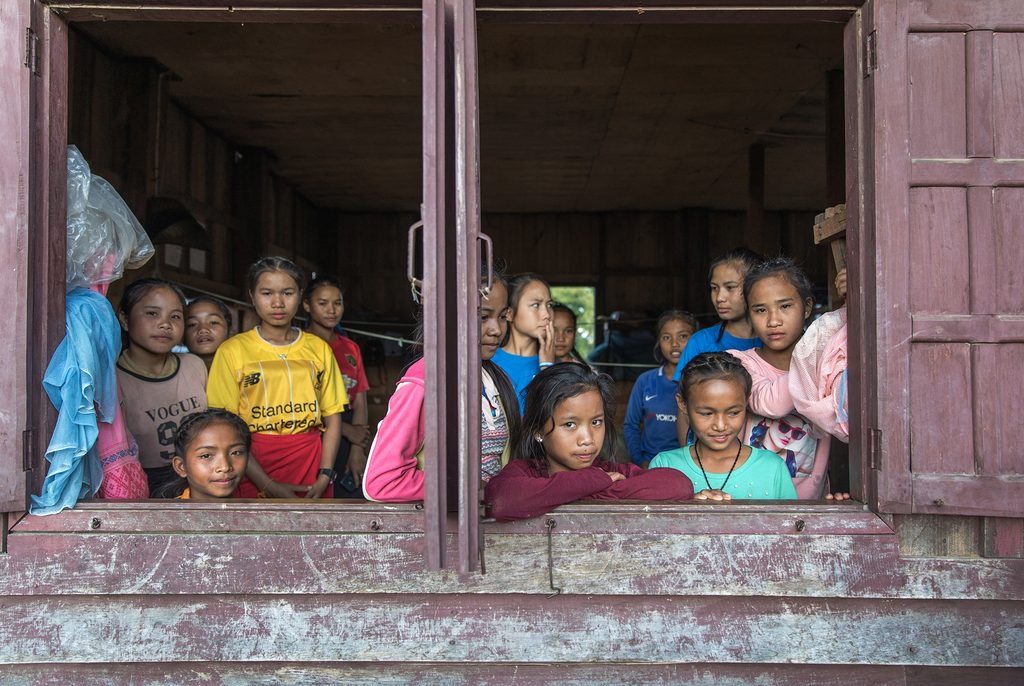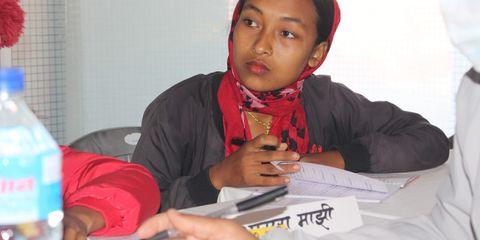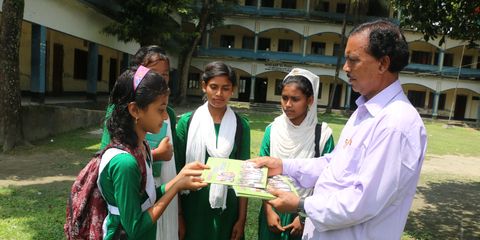Education Matters: Removing barriers to get girls educated in Lao PDR
For many girls in rural areas of Lao, routes back to education after drop-out due to poverty can be strenuous, and often lead to an early or forced marriage.

With a heavy bag of rice on her head and a pile of books bulging out of her bag – 11-year-old Khai’s classmates are always surprised to see the smile beaming from her face as she happily and clumsily skips the long journey to school. Yet Khai does not mind; her education journey used to be much more troublesome than carrying something heavy.
In the past, she only dreamed of completing secondary school. Each day after school, she returned to her farmhouse in the mountains of northern Laos, where she studied, hoping to continue school and imagining a future very different from her mother or grandmother.
But as her family’s economic pressures grew, her worst fears began to materialize.
“I almost cried when I heard that my parents could not afford my secondary education and might take me out of school. I knew that my parents did not want to do so, but they had no choice,” said Khai.
Then she found hope. Thanks to a scholarship scheme by Plan International Laos, her fears were averted, and she could continue her studies. And now she skips happily to school every day.
Yet, for many other girls, routes back to education after drop-out due to poverty can be much more strenuous, and often lead to an early or forced marriage. Throughout rural Laos, there is a strong correlation between child marriage and lack of access to education: Nearly 60 percent of women aged 20-24 with no education were married before the age of 18, compared to 16 percent who completed secondary education.
That is why Plan International Laos puts education, including comprehensive sexuality education, at the forefront of its actions against child marriage. Thanks to collaborations with northern communities – including community leaders, parents, teachers, school heads, local governmental organizations – some of the obstacles to young girls’ education are starting to diminish, and child marriage is gradually decreasing.

Student Clubs: a safe space to counter child marriage
Driving this change is the creation of numerous student clubs in secondary schools in Laos’ rural north – facilitated by the Ministry of Education and Sports in partnership with Plan International Laos. A safe space for collaboration and empowerment, these clubs allow young people, including boys, to discuss and learn about girls’ rights, including the negative impacts of child marriage, gender equality, sexual reproductive health, and the importance of education.
“The student club activities helped me to understand sexual and reproductive health and rights. I now know why girls and women menstruate and when it is too young to get married,” said Vanissa, a 12-year-old student club member. “So, I think I will make the decision myself when I am ready for marriage, but not now!”
The project is having an impact. In Vannisa’s school, the dropout rate has decreased from 11 percent in 2018 to seven percent in 2021. Such impacts are reflected throughout the northern region, with reduced marriages and increased attendances at many schools. Students and teachers alike attribute these positive trends to the student clubs.
“They have learnt about their rights, especially their right to education. Some of my female students now come to me and share their problems, and we are able to find a solution. This is the great change in our school,” said Simone, a 28-year-old teacher and facilitator at a student club.
Young women say the clubs offer them insights into how to better prepare for their futures.
“Before the club, I didn’t know much about girls’ rights. My dream was to get married and have a child after completing lower secondary school this year, but now it’s changed,” said Kaenthong, a 14-year-old student club member. “I know girls have a right to education and can have the opportunity to get a well-paid job.”
“I know girls have a right to education and can have the opportunity to get a well-paid job.”
Scholarships to help girls stay in school
These clubs have been the driver in giving girls previously unattainable perspectives. But in many communities, access to education and inequality remains commonplace and the most-pressing concern.
“It’s common for parents to encourage their first child, in particular girls, to sacrifice their education to look after their siblings and contribute to the family income,” explains a northern province village chief.
“It’s common for parents to encourage their first child, in particular girls, to sacrifice their education to look after their siblings and contribute to the family income,”
Improving access to education for many people in more rural and ethnic communities is essential to ensure girls can expand their minds and learn about their rights.
“When a family is poor, the parents think the only option is to marry their daughter off, even though her education should come first,” said Tamon, a 15-year-old female student club member.
Hence, the scholarships are helping poorer students stay in school. Working together with parents, teachers, village authorities, and the district education bureau, children from families unable to cover education costs are getting the help they need. Last year, Plan International Laos provided 767 scholarships to adolescent girls and 11 to adolescent boys across Northern Laos, just like Khai.
Khai’s mother is appreciative of the support her daughter received.
“If Khai hadn’t received these learning materials, I am afraid that she would also have been taken out of school to work in the fields with us, because going to secondary school costs us even more than primary school,” she said.
11-year-old Houm, another scholarship recipient, hopes news of the financial assistance reaches other girls.
“I hope this scholarship will help convince my parents and people in my village that education is important and necessary for all children, and find a way to support their education,” she said.
The factors pushing young girls to child marriage and drop out of school remain multi-faceted and complicated in Northern Laos. On top of lack of regard for girls’ education, tradition continues to dictate that girls and women are responsible for all the housework, and domestic violence and early marriage are accepted as the norm. Additionally, unpredictable rainfall due to climate change leaves many families with a weak harvest and little to pay for their children’s school needs. Coupled with a lack of close secondary schools for many rural villages, families living in poverty can often not afford to support their children’s education, which affects girls the most.
The obstacles are numerous and crippling for girls. However, by improving access to schools and the environments when girls get there, some of the factors pushing them out of school and into marriage are now beginning to shift, and optimism can be seen radiating from girls freely able to go to school.
With the student club in full effect in Kaenthong’s school and reaching both boys and girls, she feels confident and ready to learn: “Both boys and girls know more about their rights, and girls are bold enough to stand up for themselves. I know that change takes time, and it won’t happen quickly, but I am happy with this progress.”
I know that change takes time, and it won’t happen quickly, but I am happy with this progress.”
And Khai’s scholarship has filled her with hope: “I felt lucky and happy that I was one of the girls selected for the scholarship. I will be able to continue my schooling even if I have to always walk and carry rice and my supplies for hours to reach the school.”
Categories: Campaigns, Education, Protection from violence, Sexual and reproductive health and rights


